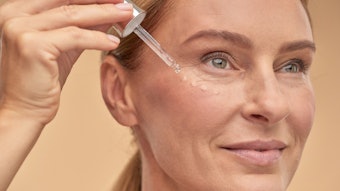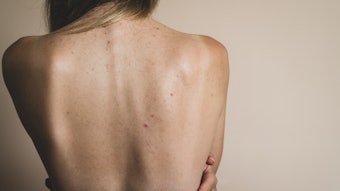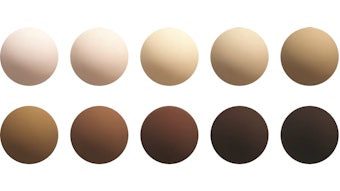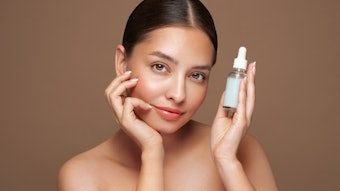Patent Picks are compiled by the editors from publicly available sources. This edition features recent inventions that aid in formulating to improve product efficacy; including a sweat-absorbing complex for deodorant, methods of producing homogeneous films for delivery, an approach to extend hyaluronic acid longevity, coated nanoparticles to localize thermal treatments, a complex to improve adhesion in fillers, a non-silicone means to boost silicone effects, and more.
Log in to view the full article
Patent Picks are compiled by the editors from publicly available sources. This edition features recent inventions that aid in formulating to improve product efficacy; including a sweat-absorbing complex for deodorant, methods of producing homogeneous films for delivery, an approach to extend hyaluronic acid longevity, coated nanoparticles to localize thermal treatments, a complex to improve adhesion in fillers, a non-silicone means to boost silicone effects, and more.
Sweat-absorbing complex for deodorant
U.S. Patent 8900609
Publication date: Dec. 2, 2014
Assignee: Coty B.V.
This invention relates to a hydrous deodorant containing a sweat-absorbing complex comprising at least: one water-absorbing component, one surface-active agent, one electrolyte and one solvent and/or vehicle. This complex is in the form of emulsified particles, which are at least partially covered with said surface-active agent and present in a three-dimensional, water-swellable network. The electrolyte also is incorporated at least partially in the interstices of the three-dimensional network.
Approach for non-self-aggregating, homogeneous film
U.S. Patent 8900498
Publication date: Dec. 2, 2014
Assignee: MonoSol Rx, LLC
According to these inventors, films made via the traditional Fuchs process suffer from the aggregation or conglomeration of particles, making them non-uniform. This randomly distributes the film components, including any active present. The present invention therefore relates to the production of films that demonstrate a non-self-aggregating uniform heterogeneity. The films contain a polymer component, which includes polyethylene oxide optionally blended with hydrophilic cellulosic polymers, and also can contain a pharmaceutical and/or cosmetic active agent. The resulting films exhibit a no more than 10% variance in active agent per unit area.
Extending hyaluronic acid longevity
U.S. Patent Application 20140349959
Publication date: Nov. 27, 2014
Inventors: D. Stroumpoulis, C.S. Mudd and A. Tezel
According to the inventors, there appears to be a relationship between youthful skin and the presence of a strong hyaluronic acid (HA) network in the intercellular matrix. Unfortunately, non-cross-linked and cross-linked polysaccharide chains such as HA are subject to degradation through different pathways; e.g., enzymatic and free radicals, thus limiting the polymer's longevity. The present invention therefore addresses these issues by decreasing the rate of natural decomposition and increasing the product's persistence in vivo by including at least one polysaccharide degradation inhibitor.
Improving cosmetic application properties
U.S. Patent Application 20140348769
Publication date: Nov. 27, 2014
Assignee: L'Oréal
This patent addresses the need for cosmetic compositions with improved properties, particularly wear, feel and texture characteristics. Commercial products containing silicon resins such as MQ resins are known, and provide good long wear properties and/or transfer-resistance. However, according to these inventors, such compositions possess poor application properties and feel upon application due to the film formed by the MQ resin. In response, disclosed here is a cosmetic composition comprising at least: one silicon resin with at least one T unit; one phenylated oil; and one gelling agent.
Coated nanoparticles to localize thermal treatment
U.S. Patent 8895071
Publication date: Nov. 25, 2014
Assignee: Sienna Labs, Inc.
While methods involving light and lasers are promising for the treatment of skin disorders, they are still insufficiently effective; methods are still needed to localize the photo-destruction in skin without affecting surrounding tissues. In response, provided herein are compositions and methods for the targeted thermomodulation of cell populations and tissues. In particular, in one embodiment, the thermal treatment of a pilosebaceous unit with coated metal nanoparticles is disclosed.
Improving the adhesion of additives in fillers
WIPO Patent Application WO/2014/186510
Publication date: Nov. 20, 2014
Assignee: Reedy International Corp.
Disclosed herein are compositions including fillers coated with adhesion-promoting material to assist in the adherence of additives, preferably colorants, to the particles. The filler, adhesion-promoting material and additive can be mixed in slurry and dried, and the resulting filler particles are useful in applications such as paper coatings, plastic compositions (both foamed and non-foamed), inks, paints, cosmetics, textiles and the like.
Boosting silicone effects with reduced silicone content
WIPO Patent Application WO/2014/184315
Publication date: Nov. 20, 2014
Assignee: DSM IP Assets
According to these inventors, although silicones impart beneficial effects, there is ongoing demand to reduce their amounts in formulations. Thus, there is ongoing demand for compositions that exhibit a silicone-like feel but using as little silicone as possible. Surprisingly it has been found that the addition of relatively low amounts of polymethylmethacrylate beads as a texturing agent to a cosmetic composition incorporating a silicone oil, such as cyclomethicone or polysilicone-15, significantly boosts the silicone feeling after application to the skin.
Maintaining function, aesthetics with UV protection
U.S. Patent Application 20140341823
Publication date: Nov. 20, 2014
Assignee: LVMH Recherche
These inventors have discovered a means to retain the efficacy and aesthetics of skin care or makeup while additionally providing satisfactory sun protection. The described process and composition includes the application of a first layer of cosmetic comprising an oil phase and, optionally, an aqueous phase; and the application of a second anhydrous layer comprising at least 70% w/w powder selected from fillers and pigments, and an oil phase. In addition, at least one of these layers, preferable the second, contains at least one UV filter, preferably a liposoluble one. Specifically, the first composition is a makeup foundation or skin care base, and the second is a loose or compact powder.










